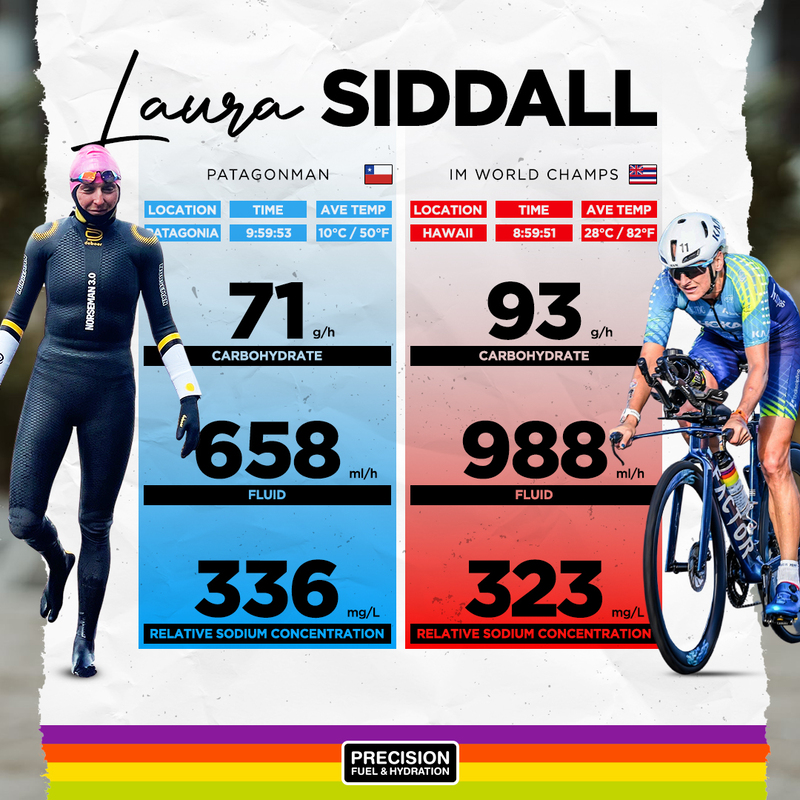While hydration is a big focus for athletes racing in the heat, we receive a lot of feedback from athletes who've struggled to nail their strategy in the cold because the conditions have impacted their ability to use their hands to pick up bottles and open gels!
So, we asked pro triathlete, Laura Siddall, to share her insights after winning the Patagonman Xtreme Triathlon in notoriously cold conditions. Having finished in the top-25 in each of her five appearances in the brutal heat and humidity of the IRONMAN World Championships since 2017, Laura is perfectly positioned to explain how she adjusts her strategy for racing in hot and cold weather...
Hi Laura, how do you prepare for racing in hot weather ahead of a race like the IRONMAN World Championships?
In 2022, my training squad did a heat prep camp in Kansas for two weeks prior to Kona. The weather and terrain are actually pretty similar to Kona, so I could get good quality sessions in without overcooking myself. Prior to the heat camp, I'd also done a fair few indoor trainer sessions on the bike, where I'd wear a hoodie for extra layers and not allow myself the cooling benefits of a fan!
My preparation for Kona was a little different in 2023 as we didn’t go away for a camp. Due to my accident in May [Laura suffered a slight brain bleed after an accident at IM Brazil], I was actually using the sauna for heat prep twice a week, so we continued with that through to Kona. I also added in a couple of indoor sessions on the bike each week, again wearing extra layers and without a fan.
On the flip side, how do you prepare for racing Patagonman where the water temperature for the swim leg is known for being cold?
We did wonder if, like sauna heat prep, we could acclimatise by doing some cold plunge or ice bath type work. I did manage to get a few swims in the cold water of a lake with my full swim kit. It was a good confidence-booster and confirmed that I had the right kit. It meant that when I got to Patagonia and got in the cold water, I was expecting it and felt prepared.
What are the key changes that you made to your usual kit to account for the colder conditions?
In terms of kit during Patagonman, I used a Deboer Norseman 3.0 wetsuit, which is a thicker suit that is specifically designed for extreme cold. It has a polar fleece hoodie, and I also wore gloves and boots.
For the bike, the best decision was to do a full kit change in transition, so that I started with dry kit. I wore leggings, overshoes, gloves and a GORE-TEX jacket, while I had a space blanket down my front too. In addition, I decided to put heat packs in my shoes and gloves for warmth too.
For the run, I wore a headband to keep my ears and head warmer, and I also started with arm warmers and gloves. It was actually a little warmer on the run and you can generate heat a little easier than on the bike, so I was still able to run in shorts and t-shirt, but I carried a jacket with me in case it got colder.
When racing in the heat, I tend to use lighter kit colours, as well as the Omius headband, and I’ll try to keep my core temperature down by putting ice down my front and back.
How do you prepare yourself mentally for racing in extreme conditions?
With cold weather events, the key for me is keeping the body temperature warm to keep morale high throughout the day. I put a big focus on staying warm after getting out of the swim and at the start of the bike leg, because it would be very hard to come back from getting too cold and hypothermic.
For the boat journey to the start of the swim leg, I wore hotel slippers over my swim boots to keep my feet warmer and took a safety blanket to keep my body temperature warm.
For a hot race, it’s obviously the opposite and the focus is on keeping the body temperature cooler.
Any race, especially a full distance triathlon, will challenge you mentally. With extreme heat and cold, it’s best to prepare yourself to cover all eventualities. So, make sure that you’re confident in your kit and put yourself in a position where you’re still able to make good decisions. This is particularly important in the cold as getting hypothermic can impact your ability to think straight and function, even affecting your ability to open gels to eat or pick up bottles to drink.
When it comes to your hydration and fueling, can you talk us through the nuances of fueling in the cold?
My pre-race intake prior to Patagonman and the IM Worlds was very similar. The difference for Patagonman was that I took a bottle of hot water to sip on if I needed it whilst on the boat to the swim start.
I was slightly worried about my hands getting cold and not being able to open gels, which is why I wore gloves during the swim and the heat packs in my gloves on the bike.
I put PF 30 Gels in one flask, so in theory I just needed to access a bigger flask and suck through the valve! I think making things easily accessible is key. So, I used an aero bottle on the front of my bike with a straw to limit the need to pick up a bottle and put it back in the bottle cage more than I had to.
For the run, we had to be self-sufficient. I carried a couple of soft flasks with straws that I could easily bend and reach my mouth. Ultimately, the key was to keep my hands warm and functioning!
You can see the race nutrition numbers that Laura hit in each race below:

We asked PF&H Sports Scientist, Emily, to share the key takeaways when comparing Laura's strategy for Patagonman to the hotter IM World Champs:
- Laura’s fueling strategy was logistically similar across the two races as she used soft flasks filled with gels on the bike before carrying gels with her on the run. She hit much higher carb numbers on the bike in Kona where she was more proactive with her regular eating intervals, whereas at Patagonman she had a few problems getting gel out of her flasks and her bike computer had issues that meant she didn’t get her usual 15-20 minute fueling ‘alerts’
- Laura carried out some sweat rate testing prior to Patagonman to understand how much she would need to drink to replace her fluid losses. She reduced her fluid intake by ~300ml per hour compared to the heat of Hawaii, where she drank over a litre an hour on the bike and run
- She consumed a similar relative sodium concentration at both races, although I’d recommended increasing this as sodium has a positive influence on water retention, which is likely to be important at a race like Patagonman where cold water diuresis can come into play
Laura, how did the cooler conditions in Chile impact your hydration strategy on the day?
I had to pee a lot more than I usually do in races! I don't normally need to pee on the bike, but literally almost as soon as we started, I was bursting and then had to go another five times. We actually reduced the fluid intake per hour a little compared to hot conditions, but I was still needing to pee so much and as a result, I was really wanting to drink a lot during the back half of the run.
We asked Laura’s Sports Nutritionist, Claire Fudge, for her insight into how the cold water might’ve impacted her strategy. The 4th Discipline founder and Sweat Test Officer said:
“Cold water diuresis is a systemic body response to exposure to cold water. Essential body temperature is preserved by constriction of your blood vessels, reducing heat loss by effectively pushing blood away from the cold environment and towards your warmer core. This is typically associated with an increase in urine output during this intricate process.
"Cold water diuresis prompts your kidneys to excrete higher volumes, causing you to release that extra fluid as urine. Cold exposure initiates vasoconstriction, where blood vessels near the skin constrict, diverting blood to your vital organs to conserve heat.
"This then creates a strong thirst drive, which may lead to dehydration as you try to catch up by drinking more. The key is to redress the sodium concentration by adding additional sodium to your fluid intake, dehydration will occur.
"It’s important to remember that cold water diuresis not only leads to fluid loss, but also electrolyte loss. So, drinking fluid with a higher sodium concentration can help maintain electrolyte balance, which is crucial for optimising physiological function.
"From Laura’s summary, it may be that although she accounted for the cooler temperatures with a lower-than-normal fluid intake, she’ll likely have benefitted from increasing her sodium intake to more closely match her sweat sodium concentration.
"For context, we know from Laura’s Sweat Test that she loses 614mg of sodium per litre of sweat, whilst the relative sodium concentration of her fluid intake was somewhat below this at 336mg/L.”
Great, thanks for the insights team. I'll share some useful reading here for athletes who are looking to perform at their best in the hot or cold...
- How humidity affects hydration, endurance and performance
- Is it best to drink water or dump it on yourself to stay cool in hot weather?
- Does drinking cold drinks in hot weather improve performance?
- Can hot drinks help you perform in cold weather?
- Why do you need to pee so much when swimming long distances?
- How to deal with the dreaded 'after-drop'
